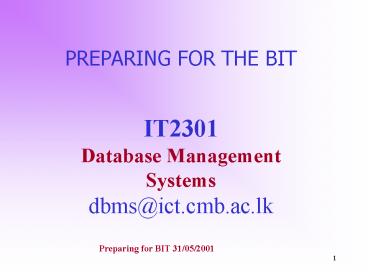IT2301 Database Management Systems dbmsict'cmb'ac'lk - PowerPoint PPT Presentation
1 / 19
Title:
IT2301 Database Management Systems dbmsict'cmb'ac'lk
Description:
Set of physical devices on which a database resides. ... Two different types of people (users and practitioners) are concerned with the database. ... – PowerPoint PPT presentation
Number of Views:40
Avg rating:3.0/5.0
Title: IT2301 Database Management Systems dbmsict'cmb'ac'lk
1
PREPARING FOR THE BIT
IT2301Database Management Systemsdbms_at_ict.cmb.ac
.lk
Preparing for BIT 31/05/2001
2
Todays Agenda
- Two Modules for Semester 2
- Database Management Systems
- Fundamentals of Software Engineering
3
Introduction to DBMSObjectives cont.
- Explain how four components hardware, software,
data and people work together to form todays
database systems.
4
Key Terms cont.
- Database System
- A database, a database management system and
appropriate hardware and personnel.
5
Database System Hardware
- Set of physical devices on which a database
resides. It consists of one or more computers,
disk drives, CRT terminals, printers, tape
drives, connecting cables and other auxiliary and
connecting hardware.
6
Database System Hardware cont.
7
Key Terms cont.
- Database Management System
- Systems software that facilitates the management
of a database. - E.g. Oracle, Access, SQL Server
8
Database System Software
- A database software includes two types of
software - General-purpose database management software,
usually called the database management system
(DBMS) - Application software that uses DBMS facilities to
manipulate the database to achieve a specific
business function, such as providing reports or
documents, which can be used by users.
9
Database System Software cont.
- Application software is generally written
standard programming language such as C, or it
may be written in a language (commonly called a
fourth-generation language) supplied with the
DBMS. - These programs utilise the command language of
the DBMS and make use of the information
contained in the data dictionary.
10
Data Dictionary/Directory (Repository)
- A subsystem that keeps track of the
- definitions of all data items (metadata) in the
database. - relationships that exists between various data
structures. - indexes that are used to access data quickly.
- screen and report format definitions that may be
used by various application programs.
11
Metadata
- Data that describe the properties or
characteristics of other data. - Some of these properties include data
definitions, data structures and rules or
constraints. Item name, the data type, length,
minimum and maximum allowable values (where
appropriate) and a brief description of each data
item. - Metadata allow database designers and users to
understand what data exist, what the data mean. - Data without clear meaning can be confusing,
misinterpreted or erroneous.
12
Metadata
E.g. Data Item Value Name Type Length Min
Max Description Name Character 30 Employee
Name ID Number 9 Employee No. Dept Character 10
Dept. No. Age Integer 2 18 60 Employee
Age Name Character 15 Dept. Name Manager Number
9 Mgr. Emp. No. Employee No. (ID)
unique Manager is an employee of the organisation
13
Program-Data/Data Independence
- The separation of data descriptions (metadata)
from the application programs that use the data. - In the database approach data descriptions are
stored in a central location called the data
dictionary. This property allows an
organisations data to change and evolve (within
limits) without changing the application program
that process the data.
14
Components of a DBMS
15
Database System People
- Two different types of people (users and
practitioners) are concerned with the database. - Users
- who need information from the database to carry
out their primary business responsibility - e.g. Executives, managers, staff, clerical
personnel
16
Database System People cont.
- Practitioners
- people responsible for the database system and
its associated application software. - e.g. Database administrators, analysts,
programmers, database and system designers,
information systems managers.
17
Components of a Database System
- Four components People, H/W, S/W, Data
- Practitioners (analysts and database designers)
in consultation with users identify data needs
and design database structures to accommodate
these needs. - The database structures are specified to the DBMS
through the data dictionary.
18
Components of a DBS cont.
- Users enter data into the system by following
specified procedures. - The entered data are maintained on hardware media
such as disks and tapes. - Application programmes that access the database
are written by practitioners and users to be run
on computers.
19
Components of a DBS cont.






























